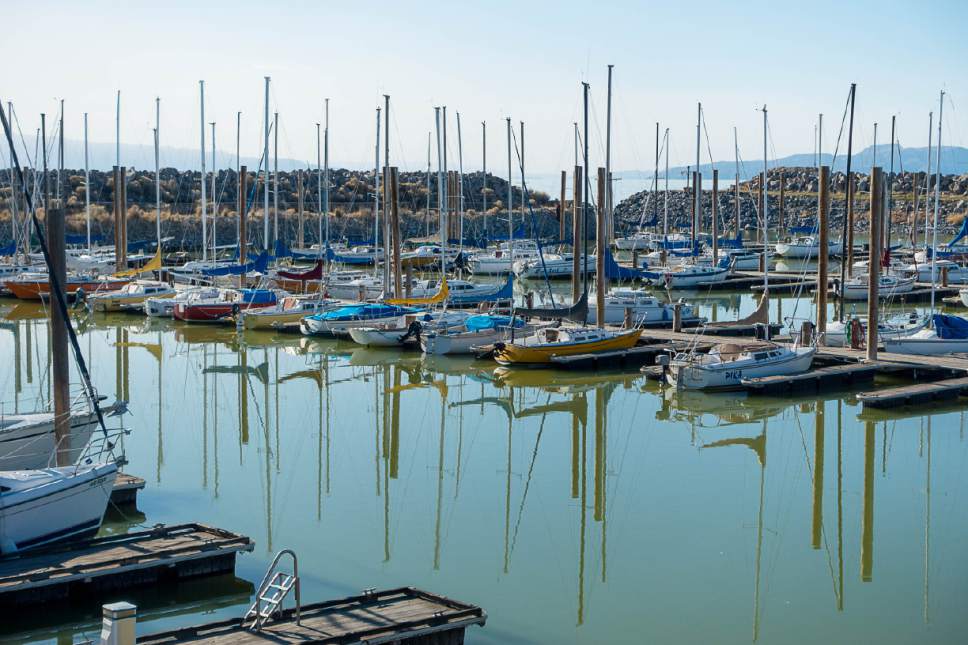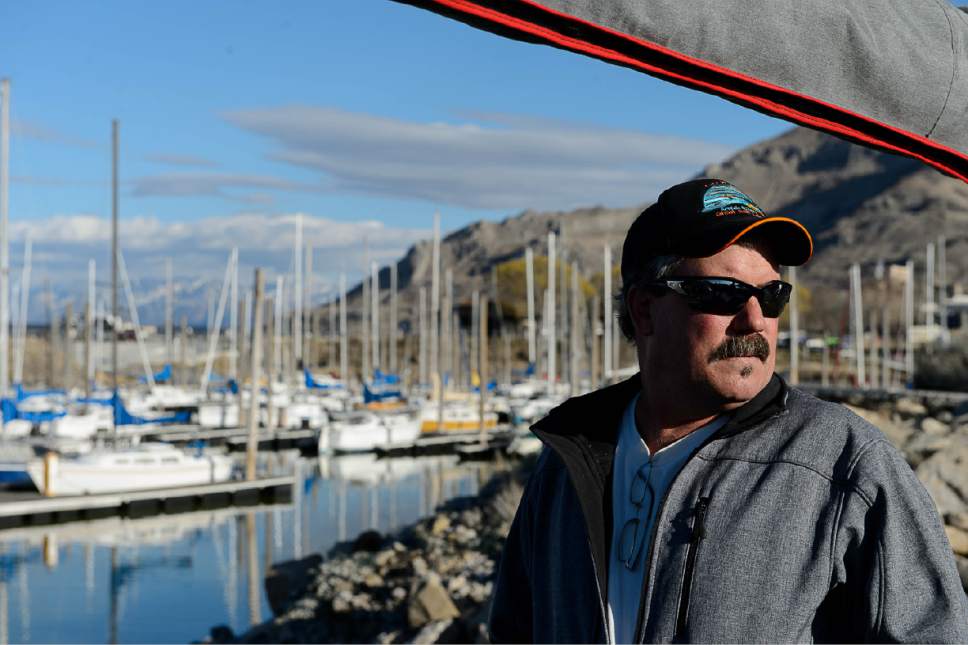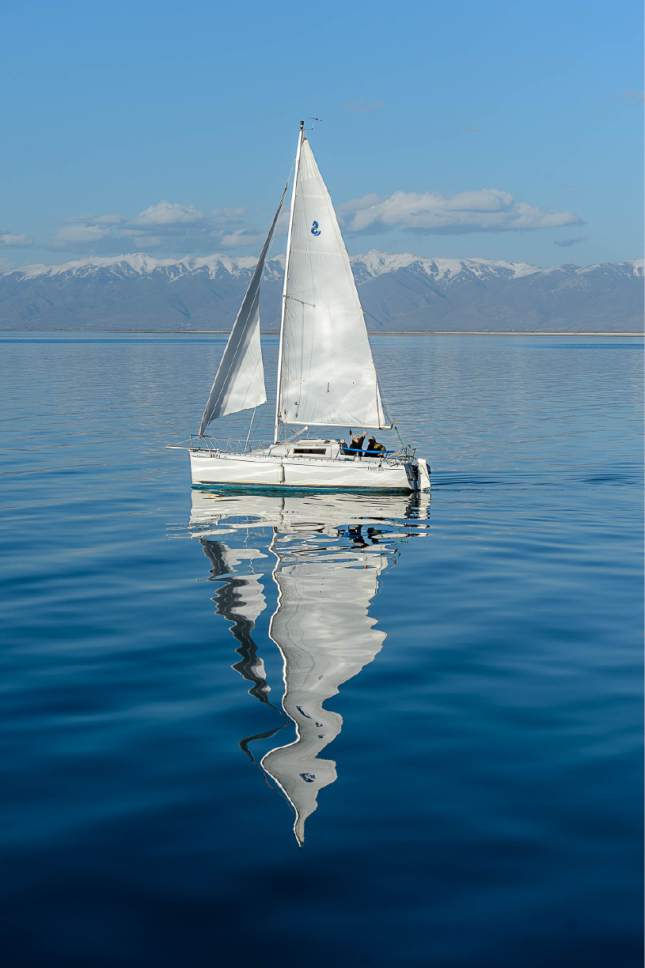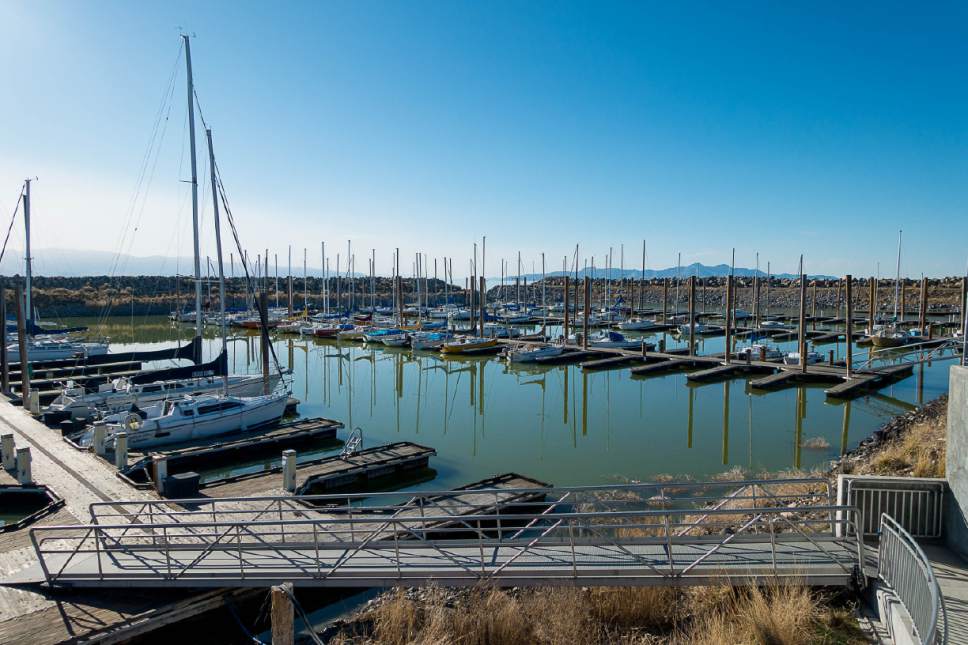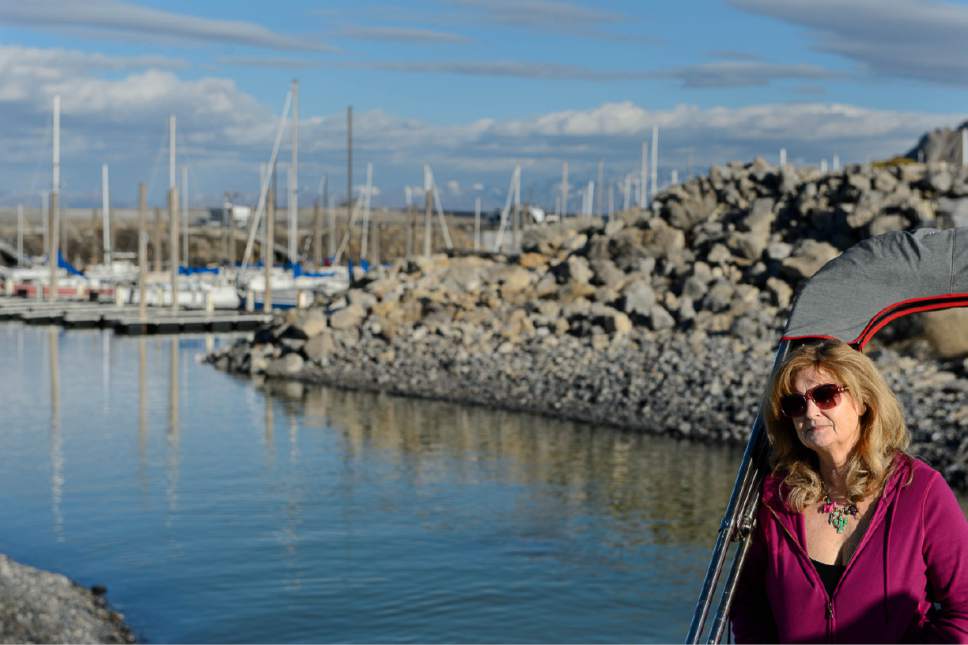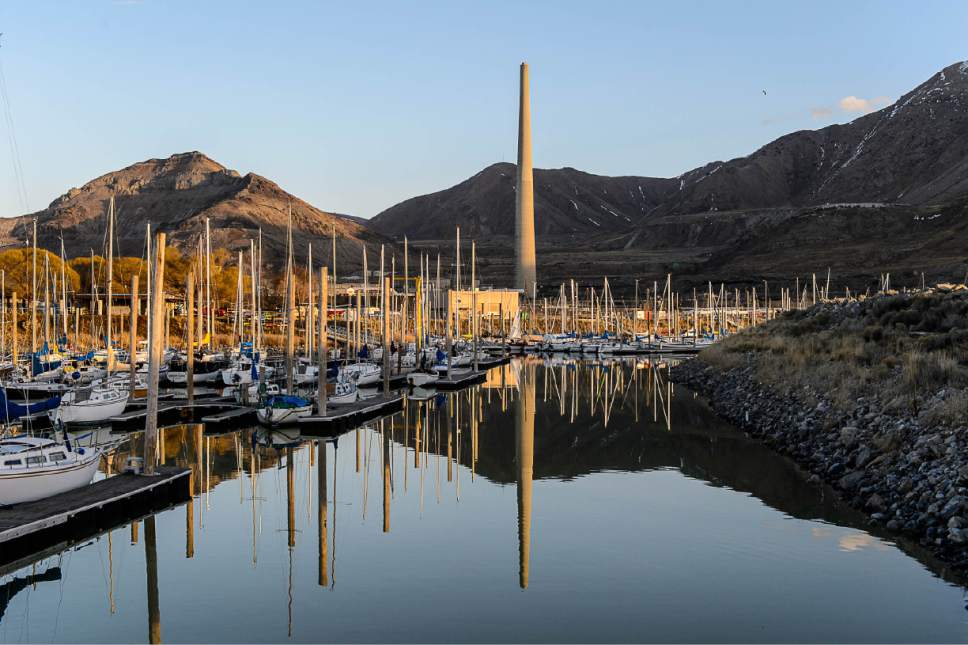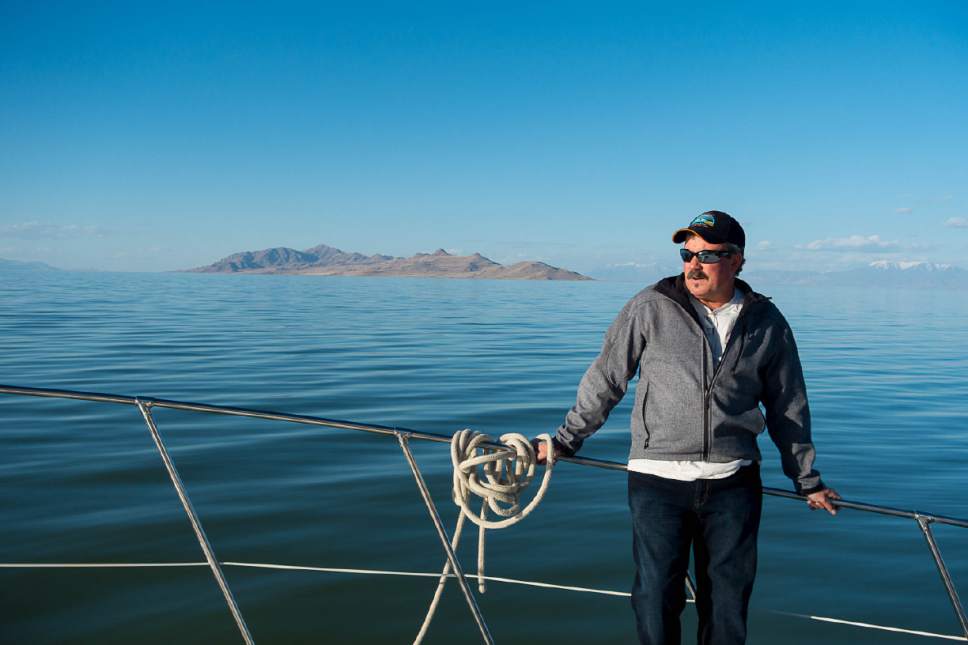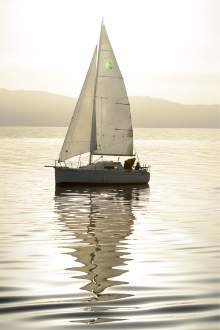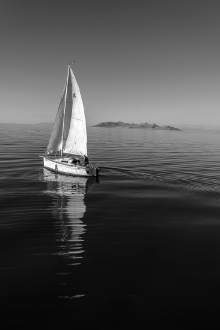This is an archived article that was published on sltrib.com in 2015, and information in the article may be outdated. It is provided only for personal research purposes and may not be reprinted.
Great Salt Lake State Marina • Long before brine shrimpers and mineral extractors culled Utah's inland sea, sailors were skimming its salty waters.
Now, low water and competing priorities could end a tradition that dates back nearly 140 years.
"If nature takes us out with no water, I can accept that," says Janet Robins of the Great Salt Lake Yacht Club. "If State Parks takes us out, we'll be upset."
After a prolonged drought and numerous upstream diversions, the terminal lake is expected to dip to a historic low, set in 1963 at 4,191 feet above sea level.
If that happens, the state marina on the Great Salt Lake's south shore could become unnavigable by this fall if it is not dredged.
Boats that draft deeper than 4 feet now risk wedging their keels in the mud on the harbor floor and in the narrow twisting channel through the breakwater. The marina has 320 permanent slips. But just 160 hardy boat owners remain, and their number is likely to plunge further.
"You can damage the boat doing that," said Gerry Harwood, who has kept his 30-foot Catalina at the marina for years. "You don't want to separate the keel from the hull, or open a stress fracture. You can get in as much trouble out on the lake as you can on the ocean."
Even so, Utah State Parks managers have targeted $1.5 million in dredging funds not at the Great Salt Lake but at Utah Lake — where sailboats are outnumbered by much more plentiful powerboats.
"We studied the number of launches and the number of people affected, the number of boaters in general that would be affected," State Parks Director Fred Hayes said. "I know the sailors are coming apart at the seams at this. I understand their disappointment."
If lawmakers follow Hayes' recommendation, the sailboat owners who remain will face a tough decision during peak water this spring. Normally, a crane is set up to put boats in at this time of year. But this spring, sailors will have to pull out their craft. Otherwise, boaters who don't pull out now could see their vessels stuck in the marina until lake levels rebound — years perhaps, Robins says.
Sailors say that would effectively kill a Utah tradition that dates to the 19th century.
"It's a huge deal to move these. If these boats leave, they are not coming back," Robins said. "When that marina is usable again, there are not boats in the state to use it. It will take a long, long time for the marina to recover."
'Magic water' • It's a sad state for one of the largest and oldest sailboat harbors between the Great Lakes and the Pacific. Half the slips are vacant, and 40-foot masts barely rise above the rocky banks.
State Parks' decision surprised members of the lake's 138-year-old sailing club, who have been paying at least $1,200 a year each in slip fees.
Concessionaires including Jim Anderson of Sailing Solutions and Dave Ghizzone of Gonzo Boat Rentals and Tours also were not consulted.
Numerous traditions have grown up around the marina, including Wednesday night races and opening day and the Blessing of the Fleet by an Episcopal priest.
Then there is the quality of the sailing on heavy water seven times saltier than the ocean.
"You have beautiful glassy water and get a good wind and have no waves," Robins said. "We call it magic water."
Last year, Ghizzone bought a 54-foot Bluewater motor yacht dubbed Sunset and hauled it from Lake Powell. He spent $120,000 refitting it for dinner cruises and signed a five-year contract with the state to serve lake visitors. Ghizzone also invested in an expensive bow thruster, necessary for tricky maneuvering in and out of the marina.
"What's scary is behind me to the right," Anderson said last week while nosing Ghizzone's Sunset through a series of 90-degree turns in the breakwater. "There is a very small margin of error. The channel is V-shaped through here."
Charging up to 20 diners $75 each for an evening tour, Ghizzone had a promising start this winter, but he said Gonzo might fold the dinner cruises if the state won't dredge.
Dredging the marina, its entrance and the channel into deep water would cost about $1.2 million. Not doing the job could easily cost the state more in terms of lost revenue and unforeseen costs, Robins argues.
Revenues raised from the Great Salt Lake marina make it one of just a handful of state parks that turn a profit.
Sailors say that's reason enough to dredge the marina.
"It sets a precedent that they won't maintain the marina," Robins said. "We feel like State Parks should protect us, and they didn't do that. This is about confidence in the state."
A tale of two lakes • Competition for the money is pitting motorized boating on Utah Lake against sailing on the Great Salt Lake.
The state marina west of Provo logged 30,000 launches last year versus 1,500 at the Great Salt Lake, Hayes told lawmakers. And park visitation at the Great Salt Lake is less than 50,000.
But sailors say Hayes' numbers distort actual activity because they don't account for the vast majority of voyages on the Great Salt Lake that don't involve a launch. And State Parks narrowed the way it counts park visitors, most of whom arrive on tour buses.
"Do you think the tourists buses are going to stop there if it's a big hole in the mud filled with abandoned boats?" Robins asked.
She estimates the marina logged 20,000 sailboat departures last year. That doesn't include rescue boats, scullers, kayakers, research vessels, duck hunters, dinner cruises and even swimmers who depart without a counted launch.
Indeed, the Utah Department of Natural Resources' own 2013 management plan for the Great Salt Lake paints a much more robust picture of recreation than Hayes describes. Park visitation was 240,000 in 2010, the document says, and about a fifth of that traffic was related to boating.
Natural Resources' plan calls for dredging the marina to keep it open for public safety, tourism and recreation. And even State Parks' website says the marina is dredged to ensure safe boating even when lake levels are low.
Sailors know they will lose when put up against water skiers. But, they note, Utah Lake has many more access points. Besides, powerboats don't require as much clearance as sailboats do.
"We don't want to start a war with Utah Lake, but it has five marinas and 19 access points. If one goes down, they can still use Utah Lake [for motor boating]," Robins said. "If our marina goes down, you can't use Great Salt Lake for sailing."
There aren't many other sailing alternatives if the marina is effectively closed.
The state marina at Antelope Island cannot function when lake levels remain below 4,196 feet. And there is a five-year waiting list to get a slip at Bear Lake, which freezes over in winter. Shallow Utah Lake is not well-suited for sailing.
Robins argues the nation's largest natural inland body of water west of the Great Lakes deserves a functioning marina — at the very least to protect public safety and maintain navigability on 1,000 square miles of water.
Natural Resources' rescue boats are called out hundreds of times a year to aid stranded boaters on the Great Salt Lake, which is under the flight paths to several airports. Planes sometimes come down on or near the water, including most recently a single-engine craft last month. State Parks rescue boats recovered the pilot's body and plane wreckage.
The hazards of rescue boating increase as the water level slips because reefs come closer to the surface.
But Hayes says public safety also is a concern on Utah Lake, because boating there will continue, even if the state marina closes.
"Utah Lake is a big, shallow water, making it a dangerous place when storms hit," Hayes said. "We need to be able to respond when people are in trouble. If access at Great Salt Lake is closed, nobody goes out."
In essence, one marina is expendable.
Brett Prettyman contributed to this report.
Twitter: @brianmaffly


